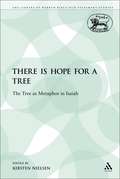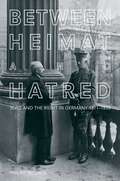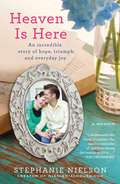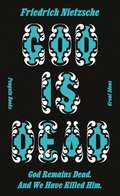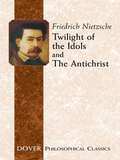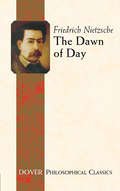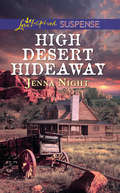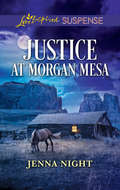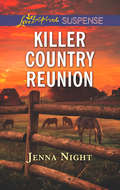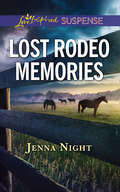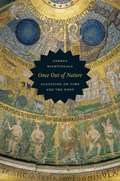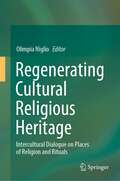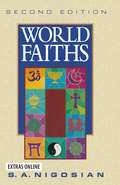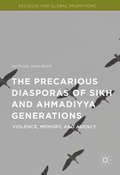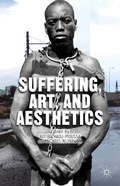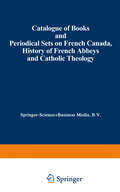- Table View
- List View
There is Hope for a Tree: The Tree as Metaphor in Isaiah (The Library of Hebrew Bible/Old Testament Studies)
by Kirsten NielsenInsights gained from the study of metaphorical language in other fields, particularly New Testament parable research, are here applied to the tree metaphors in Isaiah 1-39. The focus of investigation is the content of the metaphors , the intentions underlying their use, and the consequences of that use. The author suggests that (1) the informative function of the tree metaphors is to provide theological interpretations of the political situation; (2) the performative function of the metaphors is to engage the audience in such a way that they adopt the metaphors' interpretation of reality as their own; (3) the use of metaphorical language encourages continual reinterpretation of the original proclamation. The tree in the Garden, the felling of trees, new growth of felled trees and the forest fire, are among the images Isaiah uses to make his political statements. He shows himself to be an extremely competent rhetorician in using these images to instil an active response in his audience. The modes in which the metaphors can be reinterpreted and reapplied in new contexts are perceived as significant not only for the composition of Isaiah, but for that of subsequent religious literature.
Between Heimat and Hatred: Jews and the Right in Germany, 1871-1935
by Philipp NielsenIn the decades between German unification and the demise of the Weimar Republic, German Jewry negotiated their collective and individual identity under the impression of legal emancipation, continued antisemitism, the emergence of Zionism and Socialism, the First World War, and revolution and the republic. For many German Jews liberalism and also increasingly Socialism became attractive propositions. Yet conservative parties and political positions right-of-center also held appeal for some German Jews. Between Heimat and Hatred studies German Jews involved in ventures that were from the beginning, or became increasingly, of the Right. Jewish agricultural settlement, Jews' participation in the so-called "Defense of Germandom in the East", their place in military and veteran circles and finally right-of-center politics form the core of this book. These topics created a web of social activities and political persuasions neither entirely conservative nor entirely liberal. For those German Jews engaging with these issues, their motivation came from sincere love of their German Heimat-a term for home imbued with a deep sense of belonging-and from their middle-class environment, as well as to repudiate antisemitic stereotypes of rootlessness, intellectualism or cosmopolitanism. This tension stands at the heart of the book. The book also asks when did the need for self-defense start to outweigh motivations of patriotism and class? Until when could German Jews espouse views to the right of the political spectrum without appearing extreme to either Jews or non-Jews? In an exploration of identity and exclusion, Philipp Nielsen locates the moments when active Jewish members of conservative projects became the radical other. He notes that the decisive stage of the transformation of the German Right occurred precisely during a period of republican stabilization, when even mainstream right-of-center politics abandoned the state-centric, Volk-based ethnic concepts of the Weimar republic. The book builds on recent studies of Jews' relation to German nationalism, the experience of German Jews away from the large cities, and the increasing interest in Germans' obsession with regional roots and the East. The study follows these lines of inquiry to investigate the participation of some German Jews in projects dedicated to originally, or increasingly, illiberal projects. As such it shines light on an area in which Jewish participation has thus far only been treated as an afterthought and illuminates both Jewish and German history afresh.
Between Heimat and Hatred: Jews and the Right in Germany, 1871-1935
by Philipp NielsenIn the decades between German unification and the demise of the Weimar Republic, German Jewry negotiated their collective and individual identity under the impression of legal emancipation, continued antisemitism, the emergence of Zionism and Socialism, the First World War, and revolution and the republic. For many German Jews liberalism and also increasingly Socialism became attractive propositions. Yet conservative parties and political positions right-of-center also held appeal for some German Jews. Between Heimat and Hatred studies German Jews involved in ventures that were from the beginning, or became increasingly, of the Right. Jewish agricultural settlement, Jews' participation in the so-called "Defense of Germandom in the East", their place in military and veteran circles and finally right-of-center politics form the core of this book. These topics created a web of social activities and political persuasions neither entirely conservative nor entirely liberal. For those German Jews engaging with these issues, their motivation came from sincere love of their German Heimat-a term for home imbued with a deep sense of belonging-and from their middle-class environment, as well as to repudiate antisemitic stereotypes of rootlessness, intellectualism or cosmopolitanism. This tension stands at the heart of the book. The book also asks when did the need for self-defense start to outweigh motivations of patriotism and class? Until when could German Jews espouse views to the right of the political spectrum without appearing extreme to either Jews or non-Jews? In an exploration of identity and exclusion, Philipp Nielsen locates the moments when active Jewish members of conservative projects became the radical other. He notes that the decisive stage of the transformation of the German Right occurred precisely during a period of republican stabilization, when even mainstream right-of-center politics abandoned the state-centric, Volk-based ethnic concepts of the Weimar republic. The book builds on recent studies of Jews' relation to German nationalism, the experience of German Jews away from the large cities, and the increasing interest in Germans' obsession with regional roots and the East. The study follows these lines of inquiry to investigate the participation of some German Jews in projects dedicated to originally, or increasingly, illiberal projects. As such it shines light on an area in which Jewish participation has thus far only been treated as an afterthought and illuminates both Jewish and German history afresh.
Heaven Is Here: An Incredible Story of Hope, Triumph, and Everyday Joy
by Stephanie NielsonGo on an unforgettable journey, with a woman who has unimaginable strength.Stephanie Nielson began sharing her life in 2005 on nieniedialogues.com, drawing readers in with her warmth and candor. She quickly attracted a loyal following that was captivated by the upbeat mother happily raising her young children, madly in love with her husband, Christian (Mr. Nielson to her readers), and filled with gratitude for her blessed life. However, everything changed in an instant on a sunny day in August 2008, when Stephanie and Christian were in a horrific plane crash. Christian was burned over 40 percent of his body, and Stephanie was on the brink of death, with burns over 80 percent of her body. She would remain in a coma for four months.In the aftermath of this harrowing tragedy, Stephanie maintained a stunning sense of humor, optimism, and resilience. She has since shared this strength of spirit with others through her blog, in magazine features, and on The Oprah Winfrey Show. Now, in this moving memoir, Stephanie tells the full, extraordinary story of her unlikely recovery and the incredible love behind it--from a riveting account of the crash to all that followed in its wake. With vivid detail, Stephanie recounts her emotional and physical journey, from her first painful days after awakening from the coma to the first time she saw her face in the mirror, the first kiss she shared with Christian after the accident, and the first time she talked to her children after their long separation. She also reflects back on life before the accident, to her happy childhood as one of nine siblings, her close-knit community and strong Mormon faith, and her fairy-tale love story, all of which became her foundation of strength as she rebuilt her life. What emerges from the wreckage of a tragic accident is a unique perspective on joy, beauty, and overcoming adversity that is as gripping as it is inspirational. Heaven Is Here is a poignant reminder of how faith and family, love and community can bolster us, sustain us, and quite literally, in some cases, save us.
Heaven Is Here: An Incredible Story of Hope, Triumph, and Everyday Joy
by Stephanie NielsonGo on an unforgettable journey, with a woman who has unimaginable strength. Stephanie Nielson began sharing her life in 2005 on nieniedialogues.com, drawing readers in with her warmth and candor. She quickly attracted a loyal following that was captivated by the upbeat mother happily raising her young children, madly in love with her husband, Christian (Mr. Nielson to her readers), and filled with gratitude for her blessed life. However, everything changed in an instant on a sunny day in August 2008, when Stephanie and Christian were in a horrific plane crash. Christian was burned over 40 percent of his body, and Stephanie was on the brink of death, with burns over 80 percent of her body. She would remain in a coma for four months. In the aftermath of this harrowing tragedy, Stephanie maintained a stunning sense of humor, optimism, and resilience. She has since shared this strength of spirit with others through her blog, in magazine features, and on The Oprah Winfrey Show. Now, in this moving memoir, Stephanie tells the full, extraordinary story of her unlikely recovery and the incredible love behind it -- from a riveting account of the crash to all that followed in its wake. With vivid detail, Stephanie recounts her emotional and physical journey, from her first painful days after awakening from the coma to the first time she saw her face in the mirror, the first kiss she shared with Christian after the accident, and the first time she talked to her children after their long separation. She also reflects back on life before the accident, to her happy childhood as one of nine siblings, her close-knit community and strong Mormon faith, and her fairy-tale love story, all of which became her foundation of strength as she rebuilt her life. What emerges from the wreckage of a tragic accident is a unique perspective on joy, beauty, and overcoming adversity that is as gripping as it is inspirational. Heaven Is Here is a poignant reminder of how faith and family, love and community can bolster us, sustain us, and quite literally, in some cases, save us.
God is Dead. God Remains Dead. And We Have Killed Him. (Penguin Great Ideas)
by Friedrich Nietzsche'We have left dry land and put out to sea! We have burned the bridge behind us - what is more, we have burned the land behind us!'Nietzsche's devastating demolition of religion would have seismic consequences for future generations. With God dead, he envisages a brilliant future for humanity: one in which individuals would at last be responsible for their destinies.One of twenty new books in the bestselling Penguin Great Ideas series. This new selection showcases a diverse list of thinkers who have helped shape our world today, from anarchists to stoics, feminists to prophets, satirists to Zen Buddhists.
Twilight of the Idols and The Antichrist
by Friedrich Nietzsche Thomas Common"Books for everybody are always malodorous books: the smell of petty people clings to them," scoffed Friedrich Nietzsche. These two works, Twilight of the Idols and The Antichrist, crowned the radical philosopher's career of writing books that are decidedly not for everyone. Written in 1888, while Nietzsche was at the height of his brilliance — but shortly before the onset of the insanity that gripped him until his death in 1900 — they blaze with provocative, inflammatory rhetoric.Nietzsche's "grand declaration of war," Twilight of the Idols examines what we worship and why. Intended by the author as a general introduction to his philosophy, it assails "idols" of Western philosophy and culture (Socratic rationality and Christian morality among them) and sets the scene for The Antichrist. In addition to its full-scale attack on Christianity and Jesus Christ, The Antichrist denounces organized religion as a whole. H. L. Mencken declared that "it is, to many sensitive men, in the worst possible taste, but at bottom it is enormously apt and effective — on the surface, it is undoubtedly a good show." Students of philosophy, history, and German literature will find these works essential to an understanding of Nietzschean philosophy.
The Dawn of Day
by Friedrich Nietzsche J. M. KennedyOne of the most important philosophers of the nineteenth century, Friedrich Nietzsche's influence on modern thought has extended beyond the borders of philosophy. His works have helped shape modern anthropology, psychology, theology, and sociology. Poets, novelists, and artists have also been touched by Nietzsche's powerful concepts and perspectives.Edited by a noted Nietzsche scholar, this authoritative compendium is a vital assembly of nearly all of Nietzsche's early works. Marking the advent of his mature philosophy, these aphorisms and prose poems examine the impulses that lead human beings to seek the comforts of religion, morality, metaphysics, and art. Nietzsche proposes greater individualism and personality development, addresses issues of society and family, and discusses visions of free spirits with the courage to be rid of idealist prejudices. Written in his distinctive, often paradoxical style, The Dawn of Day presents practically every theme touched upon in Nietzsche's later philosophical essays. It is an essential guide and a fundamental basis for the understanding of the great philosopher and his work.
The Hasidic Tale (The Littman Library of Jewish Civilization)
by Gedalyah NigalStory-telling has been an integral part of the hasidic movement from its very beginnings in the eighteenth century to the present day. Stories about the holy hasidic leaders—the tsadikim, or rebbes—and their mystical powers have been a key factor in attracting followers and maintaining their devotion. Such tales were told by the tsadikim and their followers alike. The tsadikim saw them as a way to promote the movement and justify their leadership; their followers saw them as a way to exalt their masters, cleanse them of any shred of imperfection, and defend them from every trace of criticism. No other social or religious movement in the entire course of Jewish history has engaged so intensively in the telling of stories, and nor have stories occupied such a central and important place in any other intellectual movement within Judaism. Originally published in Hebrew and expanded for this English edition by a new introduction, this book is a valuable resource for anyone interested in the history of hasidism or of Hebrew literature and the literary aspects of Jewish popular culture. It acts both as a compendium of stories by theme and as a reference work for the identification of the subject-matter, authors, editors, and editions of books that have been a popular Jewish literary genre since the second half of the eighteenth century. Hasidic tales have been reprinted many times, anthologized, and even quoted by contemporary scholars, without the identity of their authors or editors being known, and without any awareness of their background and origin. In this important work, based on analysis of all the published anthologies as well as tales scattered in a variety of obscure sources, the author traces the sources and development of the different stories. An introductory historical survey is followed by full discussions of the stories themselves, grouped by subject. Among the themes covered are matchmaking and marriages, childbirth and progeny, sickness, death and the world to come, dybbuks and the powers of evil, apostasy, and many more.
High Desert Hideaway: Special Agent Lancaster County Reckoning High Desert Hideaway (Mills And Boon Love Inspired Suspense Ser.)
by Jenna NightHIDING THE WITNESS
Justice At Morgan Mesa (Mills And Boon Love Inspired Suspense Ser.)
by Jenna NightHer father’s killer is back… And now he’s after her
Killer Country Reunion: Vanished In The Night Fatal Recall Killer Country Reunion (Mills And Boon Love Inspired Suspense Ser.)
by Jenna NightHer family’s being eliminated, one by one…But he won’t let her be next
Last Stand Ranch: Protecting Her Daughter Covert Cargo Last Stand Ranch (Mills And Boon Love Inspired Suspense Ser.)
by Jenna NightHER COWBOY HERO
Lost Rodeo Memories (Mills And Boon Love Inspired Suspense Ser.)
by Jenna NightWith a stalker in the shadows… She needs a protector at her side.
Once Out of Nature: Augustine on Time and the Body
by Andrea NightingaleOnce Out of Nature offers an original interpretation of Augustine’s theory of time and embodiment. Andrea Nightingale draws on philosophy, sociology, literary theory, and social history to analyze Augustine’s conception of temporality, eternity, and the human and transhuman condition. In Nightingale’s view, the notion of embodiment illuminates a set of problems much larger than the body itself: it captures the human experience of being an embodied soul dwelling on earth. In Augustine’s writings, humans live both in and out of nature—exiled from Eden and punished by mortality, they are “resident aliens” on earth. While the human body is subject to earthly time, the human mind is governed by what Nightingale calls psychic time. For the human psyche always stretches away from the present moment—where the physical body persists—into memories and expectations. As Nightingale explains, while the body is present in the here and now, the psyche cannot experience self-presence. Thus, for Augustine, the human being dwells in two distinct time zones, in earthly time and in psychic time. The human self, then, is a moving target. Adam, Eve, and the resurrected saints, by contrast, live outside of time and nature: these transhumans dwell in an everlasting present. Nightingale connects Augustine’s views to contemporary debates about transhumans and suggests that Augustine’s thought reflects our own ambivalent relationship with our bodies and the earth. Once Out of Nature offers a compelling invitation to ponder the boundaries of the human.
Once Out of Nature: Augustine on Time and the Body
by Andrea NightingaleOnce Out of Nature offers an original interpretation of Augustine’s theory of time and embodiment. Andrea Nightingale draws on philosophy, sociology, literary theory, and social history to analyze Augustine’s conception of temporality, eternity, and the human and transhuman condition. In Nightingale’s view, the notion of embodiment illuminates a set of problems much larger than the body itself: it captures the human experience of being an embodied soul dwelling on earth. In Augustine’s writings, humans live both in and out of nature—exiled from Eden and punished by mortality, they are “resident aliens” on earth. While the human body is subject to earthly time, the human mind is governed by what Nightingale calls psychic time. For the human psyche always stretches away from the present moment—where the physical body persists—into memories and expectations. As Nightingale explains, while the body is present in the here and now, the psyche cannot experience self-presence. Thus, for Augustine, the human being dwells in two distinct time zones, in earthly time and in psychic time. The human self, then, is a moving target. Adam, Eve, and the resurrected saints, by contrast, live outside of time and nature: these transhumans dwell in an everlasting present. Nightingale connects Augustine’s views to contemporary debates about transhumans and suggests that Augustine’s thought reflects our own ambivalent relationship with our bodies and the earth. Once Out of Nature offers a compelling invitation to ponder the boundaries of the human.
Once Out of Nature: Augustine on Time and the Body
by Andrea NightingaleOnce Out of Nature offers an original interpretation of Augustine’s theory of time and embodiment. Andrea Nightingale draws on philosophy, sociology, literary theory, and social history to analyze Augustine’s conception of temporality, eternity, and the human and transhuman condition. In Nightingale’s view, the notion of embodiment illuminates a set of problems much larger than the body itself: it captures the human experience of being an embodied soul dwelling on earth. In Augustine’s writings, humans live both in and out of nature—exiled from Eden and punished by mortality, they are “resident aliens” on earth. While the human body is subject to earthly time, the human mind is governed by what Nightingale calls psychic time. For the human psyche always stretches away from the present moment—where the physical body persists—into memories and expectations. As Nightingale explains, while the body is present in the here and now, the psyche cannot experience self-presence. Thus, for Augustine, the human being dwells in two distinct time zones, in earthly time and in psychic time. The human self, then, is a moving target. Adam, Eve, and the resurrected saints, by contrast, live outside of time and nature: these transhumans dwell in an everlasting present. Nightingale connects Augustine’s views to contemporary debates about transhumans and suggests that Augustine’s thought reflects our own ambivalent relationship with our bodies and the earth. Once Out of Nature offers a compelling invitation to ponder the boundaries of the human.
Once Out of Nature: Augustine on Time and the Body
by Andrea NightingaleOnce Out of Nature offers an original interpretation of Augustine’s theory of time and embodiment. Andrea Nightingale draws on philosophy, sociology, literary theory, and social history to analyze Augustine’s conception of temporality, eternity, and the human and transhuman condition. In Nightingale’s view, the notion of embodiment illuminates a set of problems much larger than the body itself: it captures the human experience of being an embodied soul dwelling on earth. In Augustine’s writings, humans live both in and out of nature—exiled from Eden and punished by mortality, they are “resident aliens” on earth. While the human body is subject to earthly time, the human mind is governed by what Nightingale calls psychic time. For the human psyche always stretches away from the present moment—where the physical body persists—into memories and expectations. As Nightingale explains, while the body is present in the here and now, the psyche cannot experience self-presence. Thus, for Augustine, the human being dwells in two distinct time zones, in earthly time and in psychic time. The human self, then, is a moving target. Adam, Eve, and the resurrected saints, by contrast, live outside of time and nature: these transhumans dwell in an everlasting present. Nightingale connects Augustine’s views to contemporary debates about transhumans and suggests that Augustine’s thought reflects our own ambivalent relationship with our bodies and the earth. Once Out of Nature offers a compelling invitation to ponder the boundaries of the human.
Regenerating Cultural Religious Heritage: Intercultural Dialogue on Places of Religion and Rituals
by Olimpia NiglioThis book introduces important reflections on understanding the meaning of cultural-religious heritage in an international context and their relationship with issues of sustainability at the local community level. Through a holistic approach, the book charts new courses in analyzing different cultural policies and methods for preserving and enhancing cultural heritage. Stemming from an intercultural seminar promoted by the International Scientific Committee Places of Religion and Ritual (ICOMOS PRERICO) under the theme of “Reuse and regenerations of cultural-religious heritage in the world: Comparison among cultures,” the book examines the scientific diplomacy and cultural strategies promoted by countries in dialogue with the UN 2030 Agenda, as well as Agenda 21 for Culture. The book seeks to reinforce the value of local cultural policies for supporting and enhancing cultural-religious heritage through specific programs and collaborations in dialogue with government policies. This collection is relevant to scholars working in areas relating to cultural heritage, religious heritage, architectural restoration, protection of the local inheritances, law, and management of the cultural sites.
World Faiths
by S.A. NigosianWorld Faiths is a brief introduction to the major world religions. The book provides detailed coverage of the historical development of different religious traditions, and, for each religion, presents issues of faith from the perspective of the believer.
Magic and Divination in the Old Testament
by Solomon NigosianHumans, since time immemorial, have tried to discover and influence the will of spirits and deities that they believed to be in charge of their lives. As a result, all cultures have produced certain special individuals thought to be closely in touch with the powers of the supernatural world. Was this true of ancient Israel? If so, who were the occult experts and what techniques were used by them? This study explores the many practices and rituals associated with magic and divination among the ancient Israelites as documented in the Old Testament. Seeking omens and consulting seers and diviners were widely practiced, though in the biblical text such activities are roundly condemned. Solomon Nigosian's scholarly work is written in language that makes it absorbing reading for both the biblical scholar and the layperson.
Middle Eastern Founders of Religion: Moses, Jesus, Muhammad, Zoroaster and Bahaullah (The Sussex Library of Religious Beliefs & Practice)
by Solomon NigosianThis book presents an academic introduction to the life and teachings of five Middle Eastern founders of religion -- five individuals whose systems of faith, thought, and action have won the allegiance of millions. All believed to have experienced a personal encounter with the divine -- a "voice" directly from the "beyond" -- to proclaim God's message to the community or people to which they belonged. All attracted followers and opponents. Similarities in their religious outlook abound; but differences between the five pervade their approach toward society and culture, with issues of law, war, women, morality, ethics, the kingdom of God, life after death, and eternal judgment distinguishing their respective beliefs. An Introduction provides an overview of the political history of the Middle East based on four periods (Early, Persian, Hellenistic, and Roman) and a brief description of the surviving religious traditions of the Middle East (including a proposal regarding the nature of so-called "selected" individuals). Five chapter texts separately address each religious founder from the viewpoint of readers from the Judaic and Christian traditions in terms of the religious world into which each individual appeared; the traditional account as presented by available sources or evidences; the reliability of the available sources or evidences for reconstructing their biographies; and a critical assessment of both the sources or evidences and the traditional account. A concluding chapter compares the similarities and differences of the received divine messages, and notes that no new message has ever succeeded in shaking off entirely the influence of the faith from which it arose. The work has been specifically designed for student adoption in Religious Studies.
The Precarious Diasporas of Sikh and Ahmadiyya Generations: Violence, Memory, and Agency (Religion and Global Migrations)
by Michael NijhawanThis book examines the long-term effects of violence on the everyday cultural and religious practices of a younger generation of Ahmadis and Sikhs in Frankfurt, Germany and Toronto, Canada. Comparative in scope and the first to discuss contemporary articulations of Sikh and Ahmadiyya identities within a single frame of reference, the book assembles a significant range of empirical data gathered over ten years of ethnographic fieldwork. In its focus on precarious sites of identity formation, the volume engages with cutting-edge theories in the fields of critical diaspora studies, migration and refugee studies, religion, secularism, and politics. It presents a novel approach to the reading of Ahmadi and Sikh subjectivities in the current climate of anti-immigrant movements and suspicion against religious others. Michael Nijhawan also offers new insights into what animates emerging movements of the youth and their attempts to reclaim forms of the spiritual and political.
Suffering, Art, and Aesthetics
by Michael Nijhawan Ratiba Hadj-MoussaHow do we conceptualize the relationship between suffering, art, and aesthetics from within the broader framework of social, cultural, and political thought today? This book brings together a range of intellectuals from the social sciences and humanities to speak to theoretical debates around the questions of suffering in art and suffering and art.
